
Sicilian Food: 30 Iconic Dishes + What to Eat in Sicily
Sicilian food is completely different from your usual Italian cuisine. If you’re going to be spending time in Sicily, don’t expect to grab a Roman carbonara or a Florentine steak.
Instead, imagine a cuisine filled with fresh vegetables, lots of seafood, and the smallest amount of meat. Imagine eggplants and pine nuts and swordfish, wild fennel growing on the side of the road, a sprinkling of couscous here and there, calamari grilled to perfection, liqueurs made from local fruits and herbs. And — I won’t lie — Sicilians have a tendency to get creative with the organs.
If you’re planning a trip to Sicily, you’re going to want to try EVERYTHING. And while I’ve traveled to Sicily several times, on my most recent trip I made an aim to eat every major Sicilian dish that I could find. What a delicious mission that was.
Let’s take a look at what to eat in Sicily — and what makes Sicilian food so special.
Table of Contents
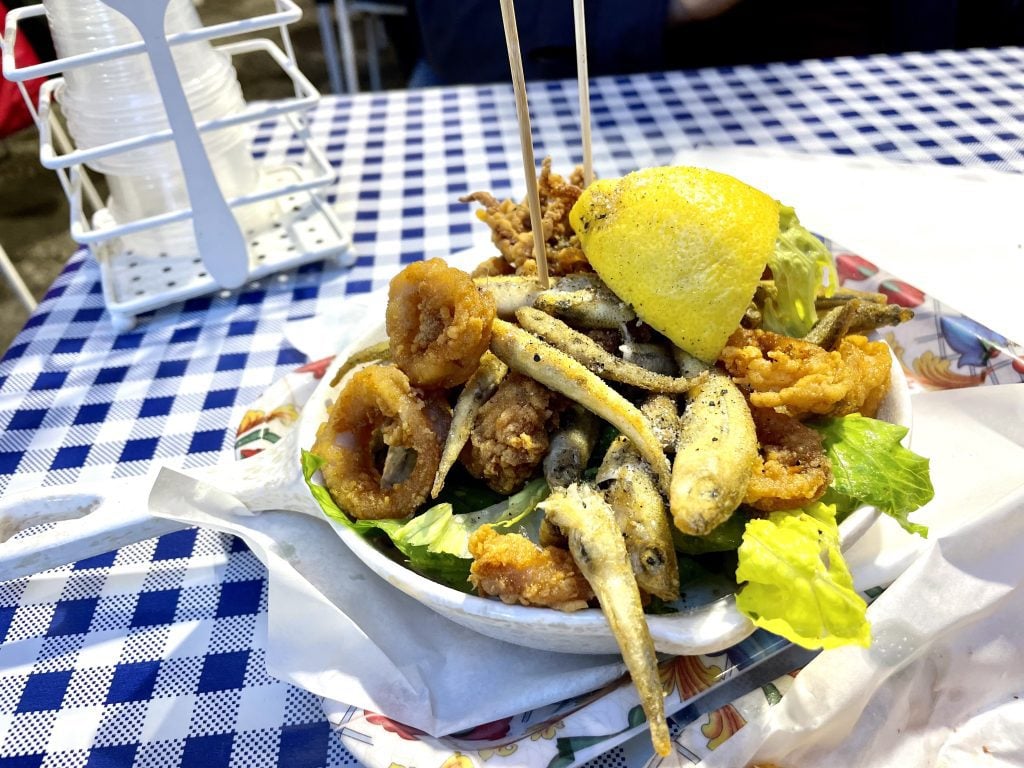
Sicilian Food Influences and History
First off, you can’t understand traditional Sicilian food without knowing a bit about Sicilian history and geography. Italy is a diverse country of nation-states that didn’t unify until 1861. Many of Italy’s 20 regions each feel like their own country — but Sicily feels especially unique.
This island in the Mediterranean has been conquered, invaded, and settled by the Arabs, the Normans, the Vikings, the Spanish, and far more.
Each culture brought their own food, turning Sicily into a delightful culinary melting pot. But above all else, Arab culinary traditions took hold deeply in Sicily, with dishes from caponata to couscous decorating Sicilian menus. Bread comes sprinkled with sesame seeds, and saffron adds fragrance and color to pasta dishes.
In short, Sicily is a lot closer to Tunis than Rome — not only by geography but by culture and cuisine as well.
(And it goes to people, too. What a surprise I got when I got my DNA test and the Sicilian side of the family was actually quite Middle Eastern!)
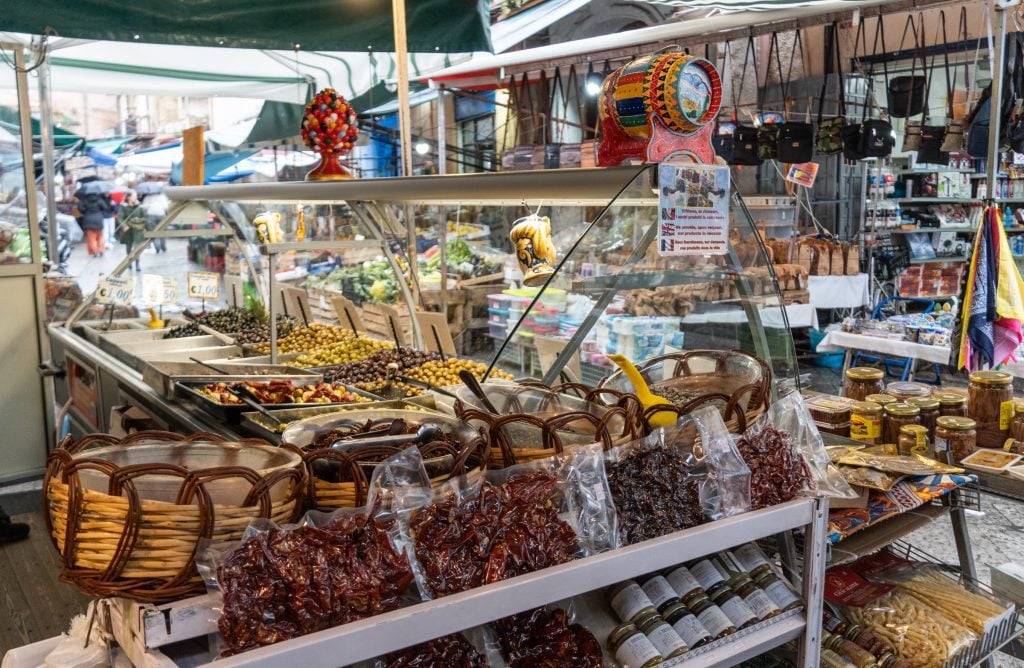
Traveling to Sicily? Start with a Food Tour
If you’re traveling to Sicily and looking to learn about typical Sicilian food, I highly, highly recommend starting with a food tour. It will give you so much context, introduce you to dishes you’ll love, and make the rest of your trip so much easier.
Streaty is a food tour company run by Sicilians! I took their ultimate Sicilian cuisine and wine tour in Palermo, which was absolutely fantastic and the best way to start my trip.
They also run a Catania food tour.
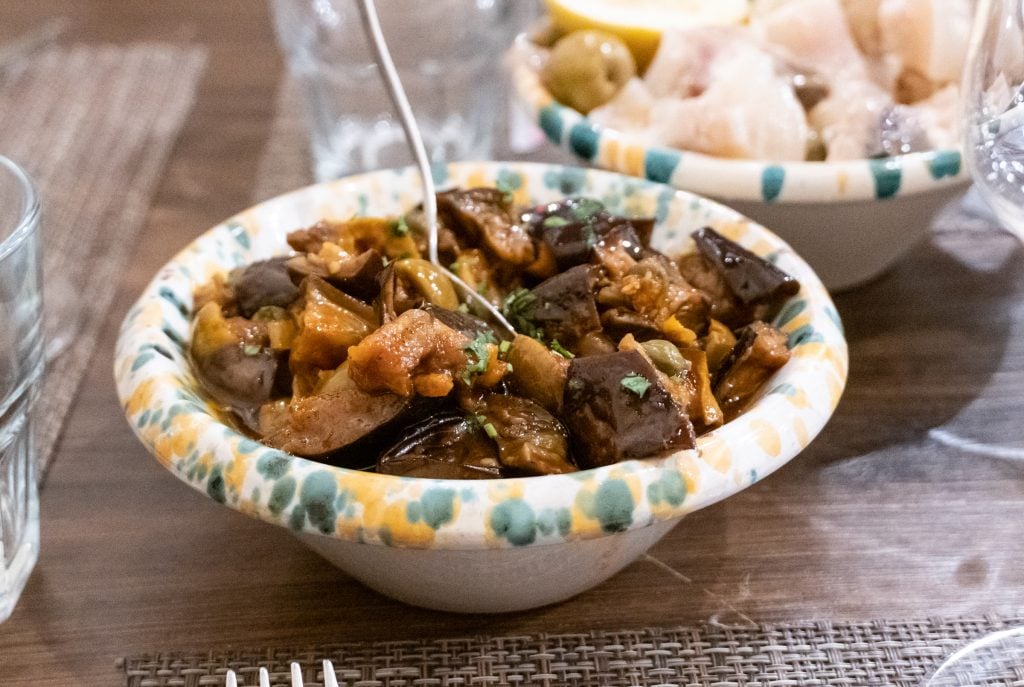
Sicilian Appetizers
Caponata
Caponata is one of the most recognizable dishes from Sicily, and one that is frequently on the table as an appetizer. This sweet and sour eggplant-based dish consists of several vegetables, cooked separately and then combined in an agrodolce sauce.
Fried eggplant is the most important component of caponata, and it also includes celery, tomatoes, capers, green olives, and olives, cooked with olive oil, vinegar, and sugar.
Occasionally you can find a more upscale caponata that includes octopus (polpo) or swordfish (spade).
Talk to Sicilians and they’ll tell you that preparing caponata is a time-consuming endeavor, each vegetable requiring a different cooking process. Many Sicilian cooks like to make a big batch of it for the season and preserve it in jars.
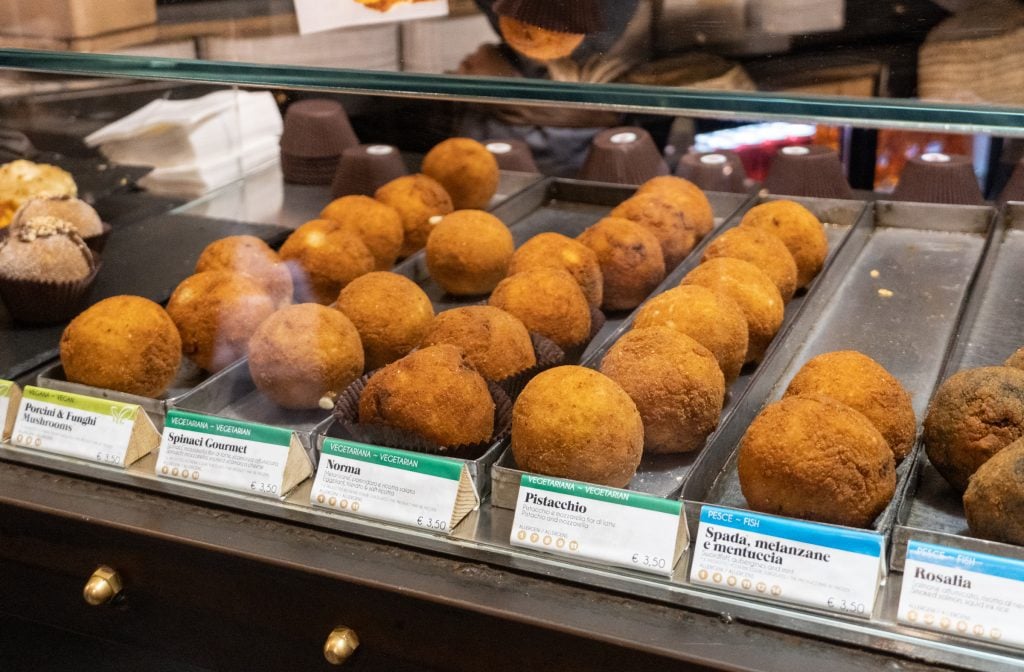
Arancini
Arancini are another beloved dish from Sicily — stuffed rice balls that are covered with breadcrumbs and deep fried. These are an easy and filling snack in Sicily; locals grab them at any time of day, and they usually cost around a euro.
Arancini are found throughout Sicily, but know that there are two distinct kinds.
In Palermo and the west, they are called arancin (singular) or arancine (plural) and are round.
In Catania and the east, they are called arancino (singular) or arancini (plural) and are conical, shaped like Mount Etna.
In either of these kinds, the fillings can be al burro (ham and cheese, usually Béchamel or mozzarella) or al ragu (tomato and meat sauce, sometimes with peas), though you can find anything from pistachios and mortadella to eggplant and ricotta salata.
Arancini are sometimes served as street food in Sicily, but you can find them in restaurants, in rosticcerie, everywhere.
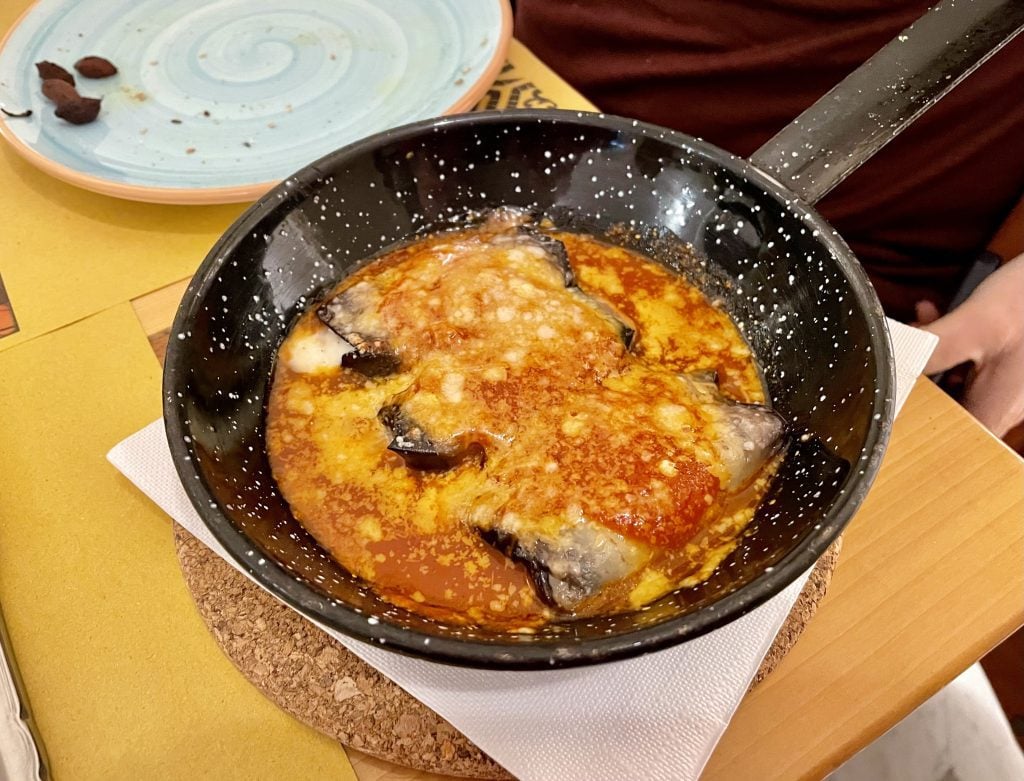
Parmigiana di Melanzane
Yet another incredibly popular dish in Sicily is parmigiana di melanzane — eggplant parmigiana. While you see this dish all over Italy, it originated in eggplant-rich Sicily.
The word “parmigiana” actually has nothing to do with parmesan cheese — food historians believe it’s related to the word parmiciana, or the wooden strips that make up Persian blinds, which describes how the dish is cut and layered.
Eggplant is sliced thinly and layered with tomato sauce and either caciocavallo or mozzarella cheese.
This is usually eaten either as an appetizer or a side dish. A fabulous accompaniment to any Sicilian meal!
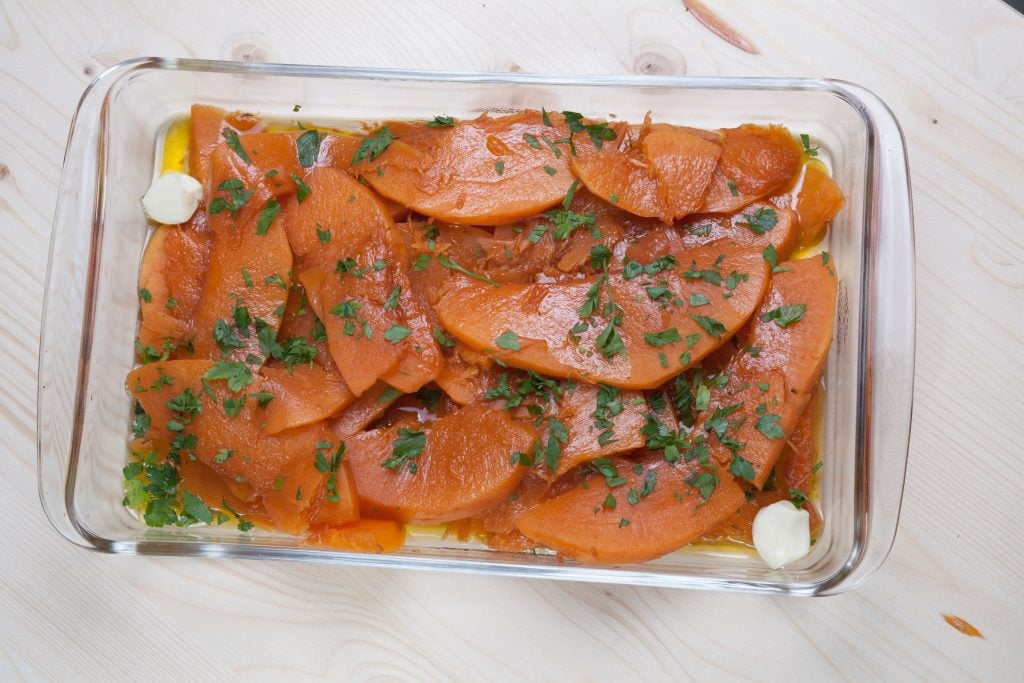
Zucca in Agrodolce
Another popular appetizer in Sicily is zucca in agrodolce — thin slices of pumpkin in agrodolce, or sweet and sour sauce.
This is called “poor man’s liver,” my Sicilian friends joked. It was created to evoke the appearance of sweet and sour liver, a more popular dish for moneyed Sicilians.
The pumpkin in question is usually a Sicilian red or yellow pumpkin, or similar squashes, cooked in a simple recipe with sugar, vinegar, olive oil, and mint.
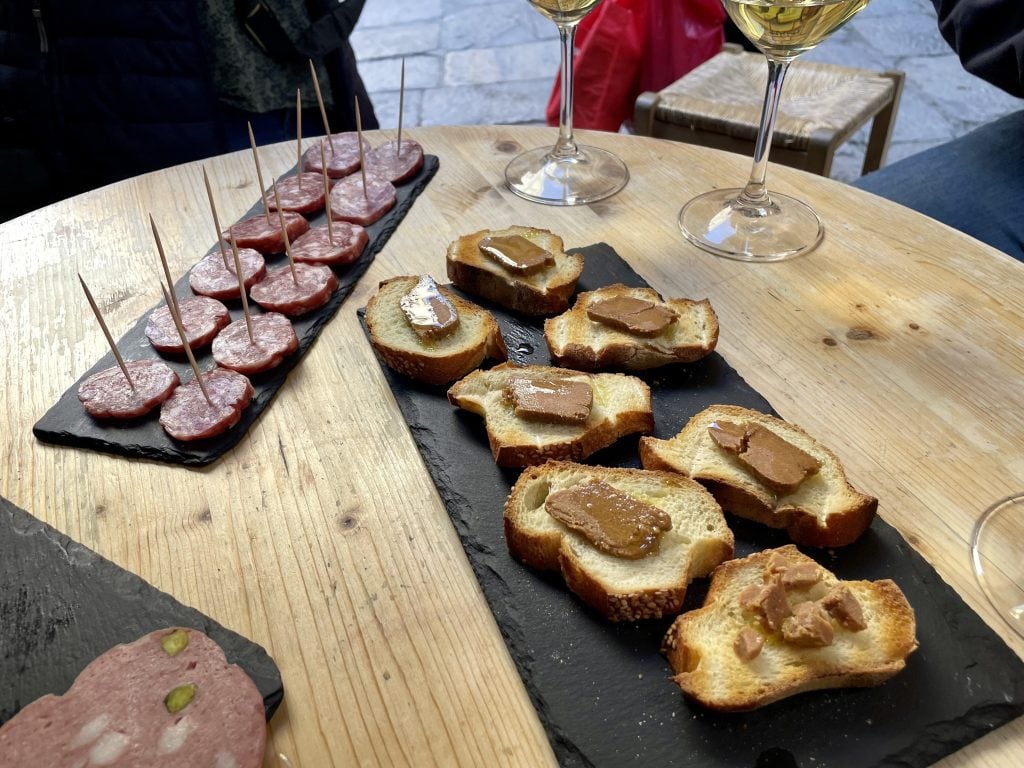
Bottarga
One of Sicily’s most unique foods is bottarga — dried compressed fish roe sac, usually made from grey mullet or bluefin tuna. It’s basically a slab of dried, salty fish, packed with umami flavor.
Bottarga is often sliced and served on crostini, or grated and added to dishes, especially pasta dishes. (You often see it as an included ingredient in five-star restaurants around the world.)
Like many Sicilian dishes, bottarga can be seen in different cultures — from Greece to Sardinia to the Arab world.
Many Sicilians have strong opinions over whether bottarga should be served with lemon. Some are very much in favor of lemon; some are adamantly against it. Try both and see what you prefer!
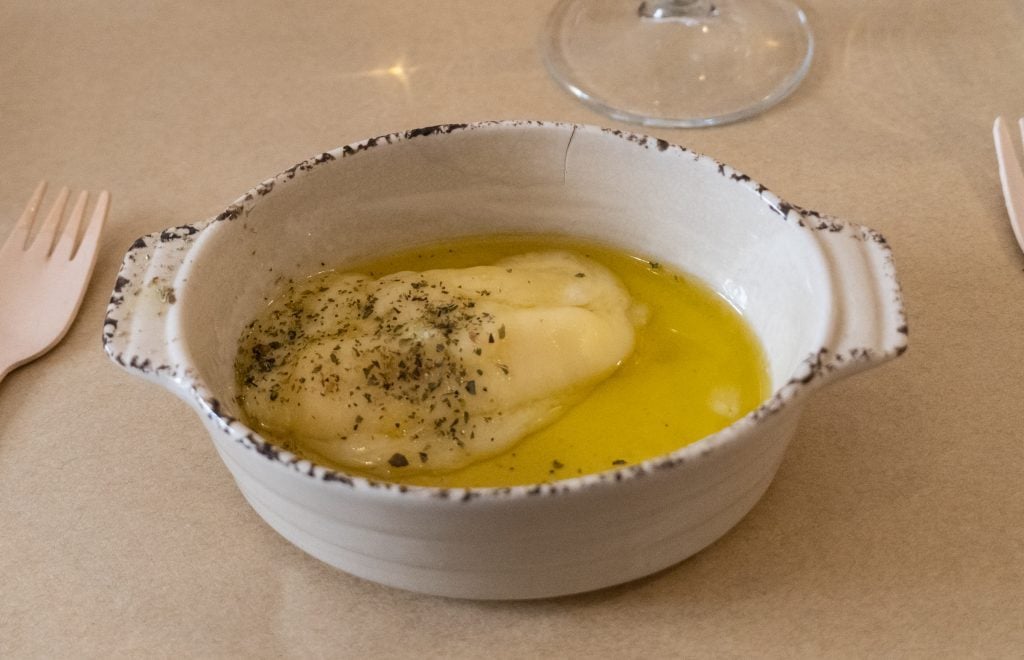
Caciocavallo all’Argentiera
Caciocavallo cheese is popular throughout Sicily — and Italy as a whole. But caciocavallo all’argentiera is a dish that you will find only in Sicily — specifically, Palermo!
In this dish, caciocavallo cheese is cooked in a pan with garlic and vinegar until melted and served in a dish topped with oregano and pepper. It’s an herby, vibrant way to enjoy melted cheese (and who doesn’t love melted cheese?).
This dish was reportedly invented by the wife of a silversmith living on Via Argentiera who had fallen on hard times. She made the cheese in the style of rabbit, and the scent was so good, people didn’t realize it wasn’t meat!
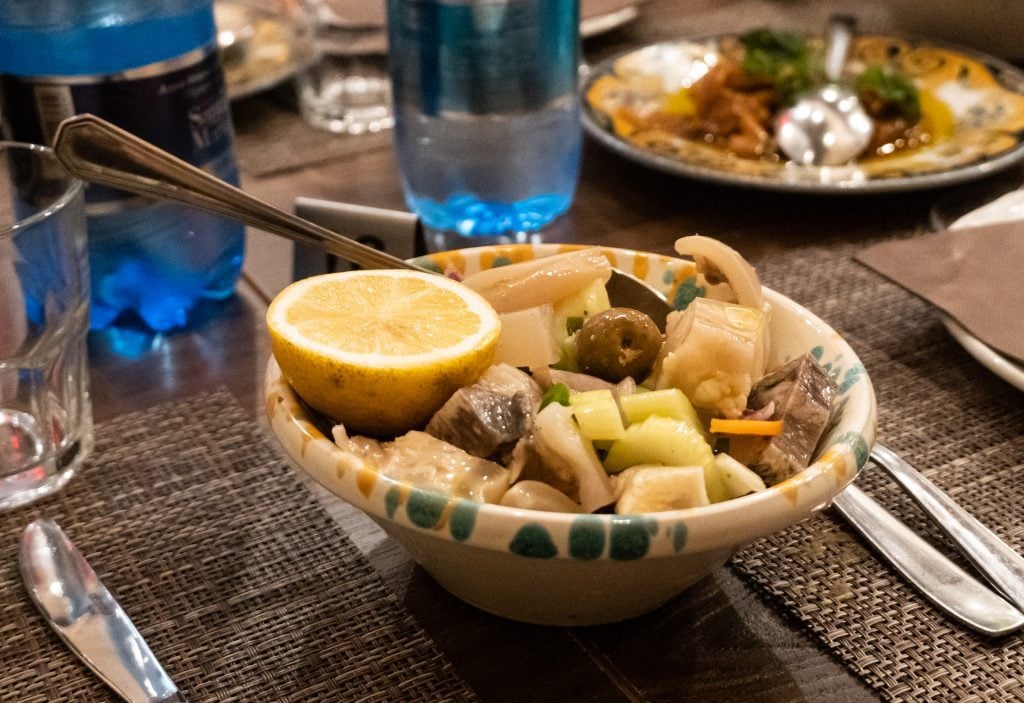
Insalata di Musso
I warn you that insalata di musso is arguably the least appealing food on this list, but it’s popular in Palermo, so I’m sharing it here. This is a salad made of boiled veal cartilage taken from the snout (musso), foot, and jaw.
The boiled cartilage pieces are cooked in olive oil with carrots, celery, and olives. It’s served at room temperature.
Adventurous eater? Go for it! Not so much? You’ll be fine skipping this one. (Then again, I’m an adventurous eater and this is the one food on this list I couldn’t finish.)
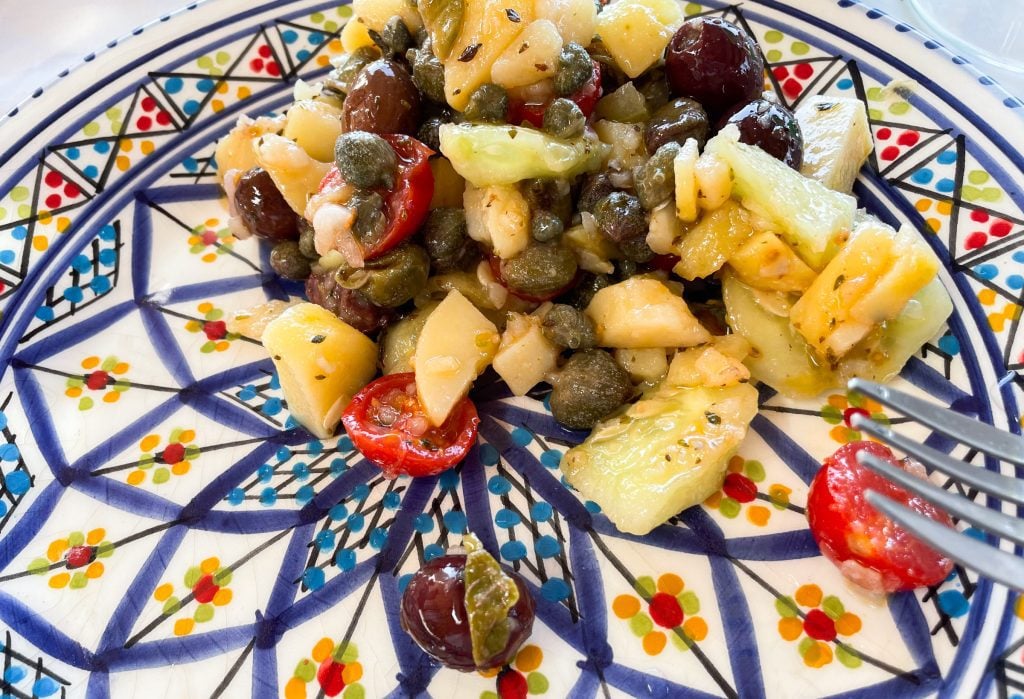
Insalata Eoliana
And now, a much better Sicilian salad. The Aeolian Islands are famous for their capers, and this is showcased in the insalata eoliana — a hearty salad that fills you up for hours.
Insalata eoliana, sometimes called insalata liparota for the island of Lipari, is Sicilian potato salad — a salad of potatoes, tomatoes, capers, and olives, topped with olive oil, lemon, and oregano. Sometimes you can find al mare versions that include tuna or octopus.
This can be served as a side dish (contorno) or main dish. It’s tough to find outside the Aeolian Islands, so enjoy it while you have it!
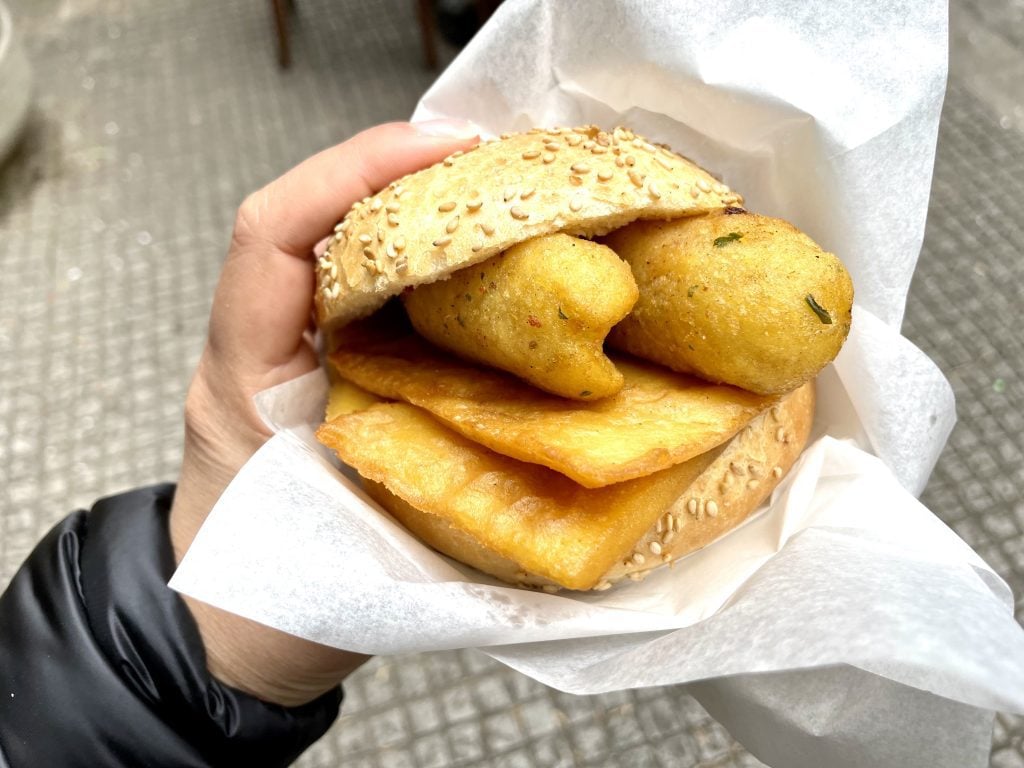
Sicilian Street Food
Panelle
In Palermo, sometimes it seems like every street snack is fried. And one of the most famous is panelle — chickpea fritters made with chickpea flour, salt and pepper, olive oil, and sometimes lemon juice or herbs. They melt in your mouth.
Panelle can be eaten on their own, but a popular street snack in Palermo is pane panelle — a sandwich with panelle served inside a sesame seed roll. Often crocchè (potato croquettes coated in bread crumbs and fried) are added to it.
It feels a bit like carbs on carbs on carbs, but this is a delicious sandwich! And if you’re a vegetarian or vegan in Palermo, this is one of your most solid lunch options.
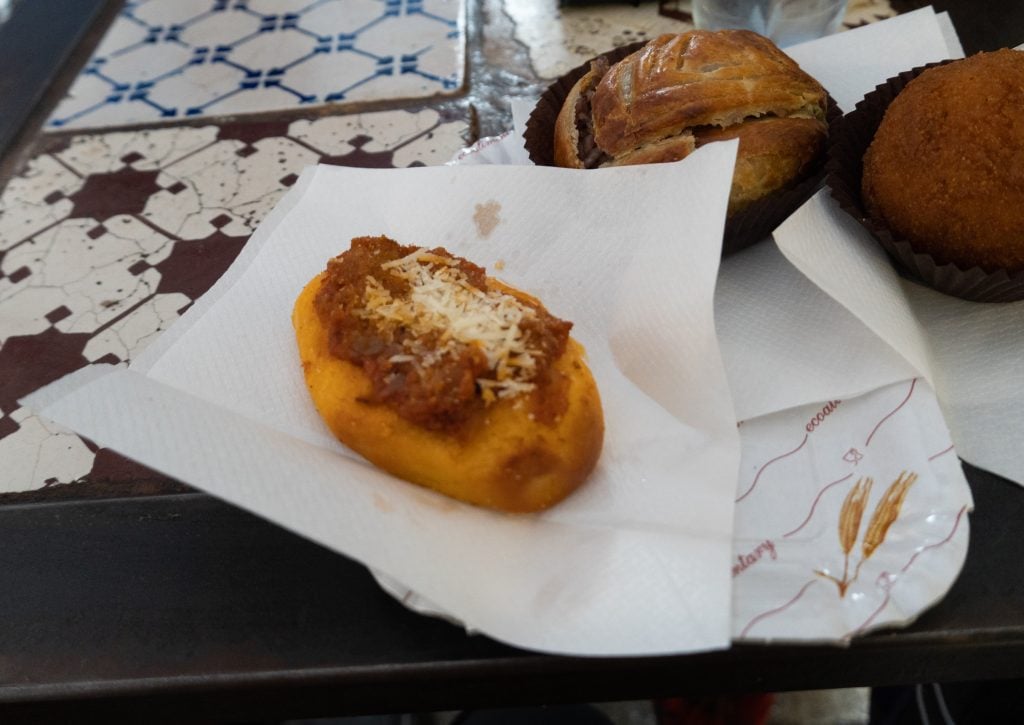
Sfincione
A sfincione is a Sicilian-style pizza slice — square, topped with tomato sauce, sometimes with grated caciocavallo cheese. This is a classic Sicilian street food specialty, but it’s often dressed up in fancier restaurants.
This dish is most popular in Palermo, and you can find versions with or without cheese, as well as versions topped with onions or anchovies. Often anchovies are part of the sauce (though don’t tell your friend who hates seafood — chances are they won’t notice).
You can see easy connections to Italian-American pizza slices. If you’ve been to L&P Spumoni Gardens in Brooklyn, or lined up for a “grandma slice” after a long night out, those are sfincione!
I even showed a picture of Rhode Island-style pizza slices to my Sicilian friends, and they all agreed — “That’s sfincione!”
These are a great dish to keep you going when you need a bite but not a whole meal.
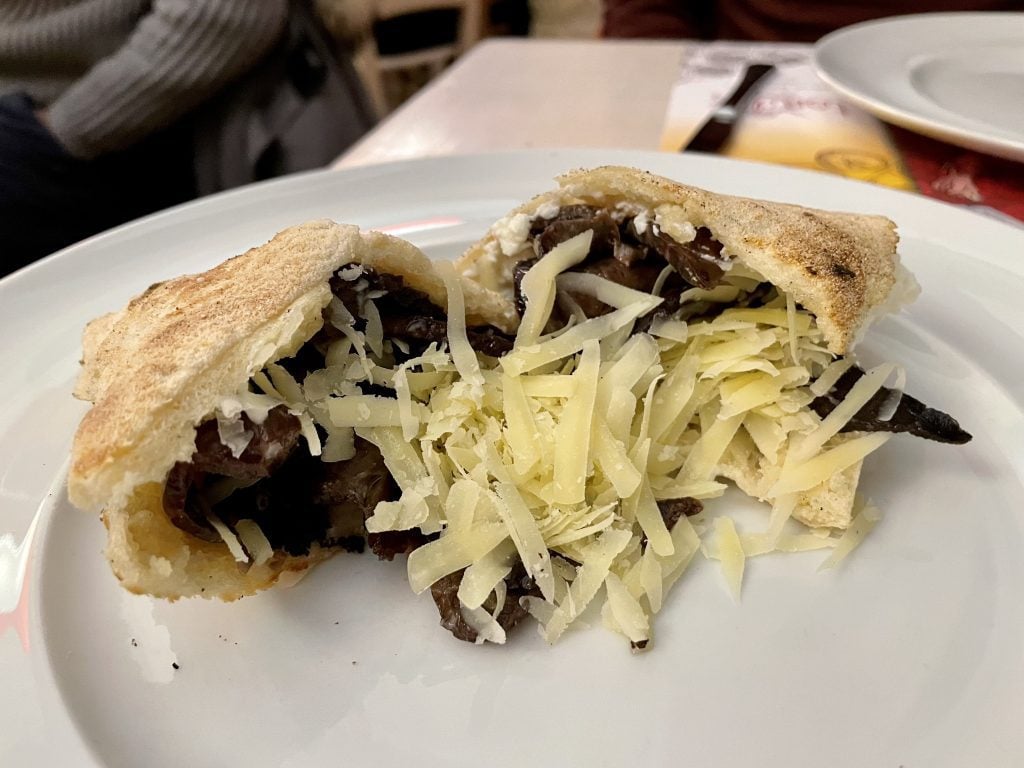
Pani câ meusa
And now one of the most intimidating Sicilian streets foods on the planet! Pani câ meusa is a sandwich made with veal spleen and lung. Yes, seriously.
Pani câ meusa is a popular street food dish in Palermo; good luck finding it elsewhere in Sicily. The spleen and lungs are boiled, then fried in lard and served on a soft roll with sesame seeds on top. It’s sometimes served with ricotta or caciocavallo cheese — this is called maritatu, or married in Sicilian, while the cheeseless sandwich is schettu (single).
It might not be your first choice for a meal in Sicily — but know that this sandwich exemplifies how nothing ever goes to waste in this part of Italy.
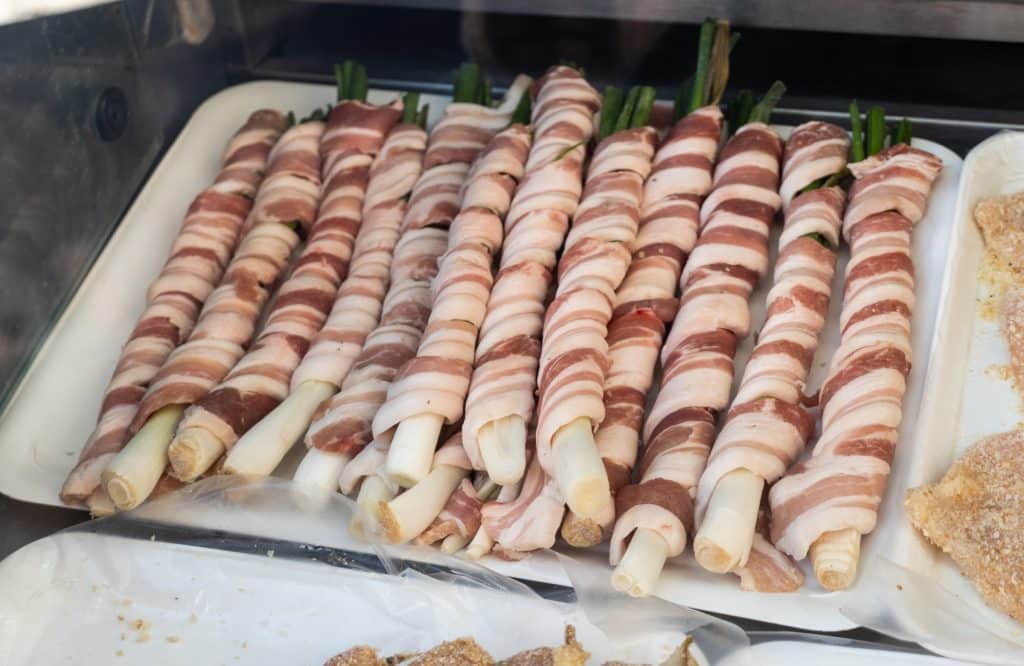
Stigghiola
And another somewhat intimidating specialty from Palermo — stigghiola! Stigghiole (plural form) are lamb or veal intestines seasoned and wrapped around a spring onion or leek, then grilled and cut into bite-size pieces.
In Palermo they call it mangia e bevi, or eat and drink. You can find these sizzling on the grill in Palermo’s markets.
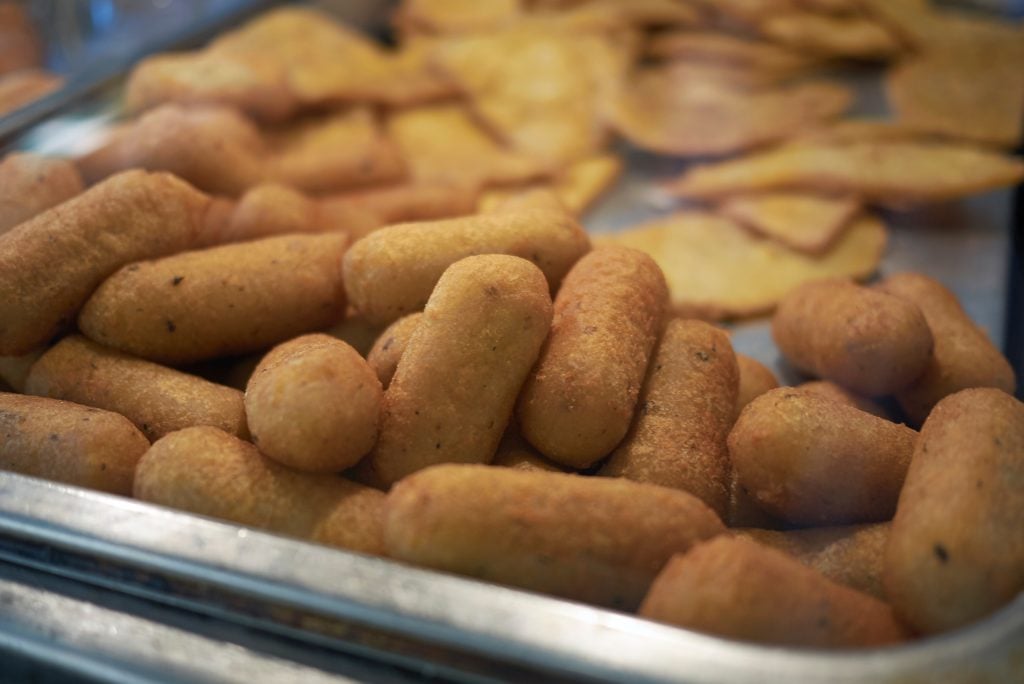
Crocchè
It seems like every culture has its own version of potato croquettes — and the Sicilians are no exception with their crocchè. This popular street food is available throughout Sicily.
Crocchè are made from mashed potatoes and eggs sometimes with grated caciocavallo cheese, then covered in breadcrumbs and fried. Mint adds a bright addition to them.
In Palermo, you can have the crocchè added to a pane e panelle sandwich — deliciously carby!
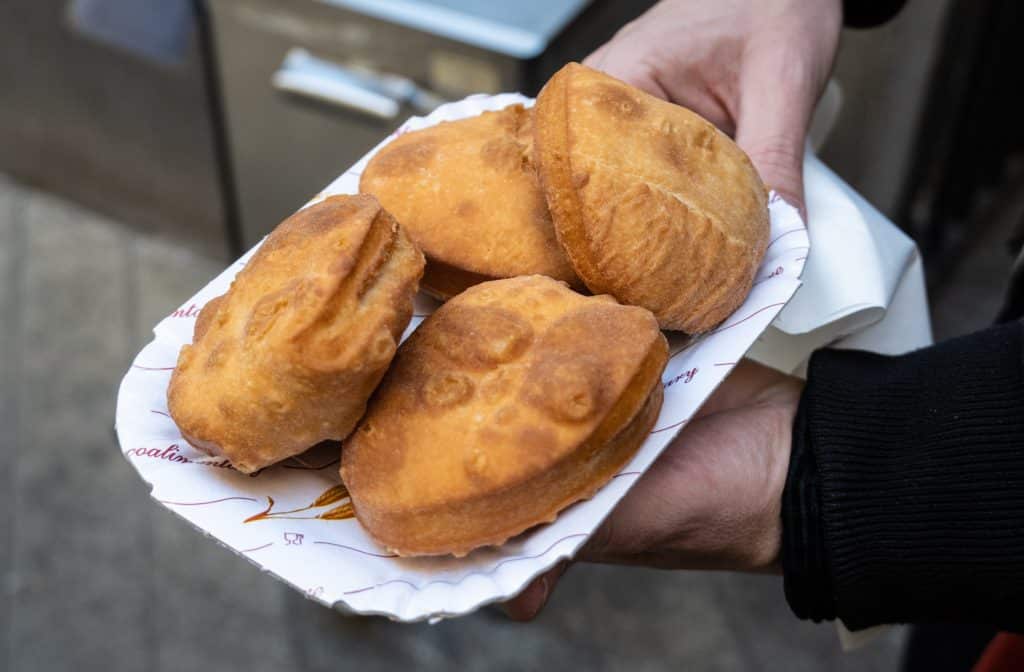
Panzerotti
A panzerotto, in essence, is similar to a calzone — a deliciously fried piece of dough with a filling in the center. Sicilian panzerotti can be picked up at a rosticceria in the morning, and they make a filling and portable breakfast in this often breakfast-averse nation.
The outside is fried and crispy, and the inside is fresh and spongy. In Sicily, panzerotti are often al burro, meaning filled with ham and cheese. If you get a good panzerotto, you won’t want anything else!
You can find panzerotti all over Italy, and they vary quite a bit regionally. Panzerotti are hugely popular in Puglia, but they tend to have a thinner outside crust and filled with tomato and mozzarella. In Naples, pizza fritta (fried pizza) is similar to Puglian panzerotti, but the term panzerotti actually refers to potato croquettes. Confusing!
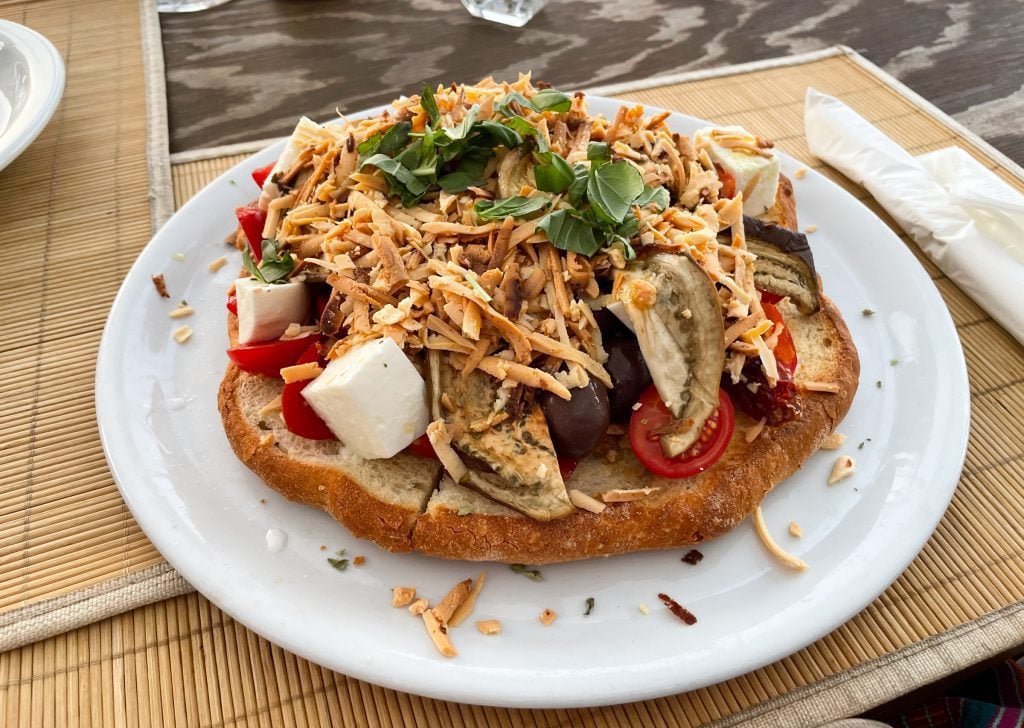
Pane Cunzatu
Pane cunzatu (also called pane cunzato) is a dish originally from the Aeolian Islands — a flatbread topped with olive oil and any kind of toppings you can imagine. Some popular toppings are vegetables like capers, tomatoes, olives, artichokes, or sun-dried tomatoes; cheeses like mozzarella or ricotta salata, and/or fish like anchovies or tuna.
Pane cunzatu is the ultimate cheap meal in the Aeolian Islands — because they are usually massive and easy to split between two people! (Some come smaller, though, especially in nicer restaurants. Check before you order.) And because everything is balanced on a giant piece of firm bread, you need to be careful to keep the ingredients from rolling off!
Strangely, whenever you find pane cunzatu outside the Aeolian Islands, it’s in sandwich form — the toppings between two pieces of bread. Much easier to eat!
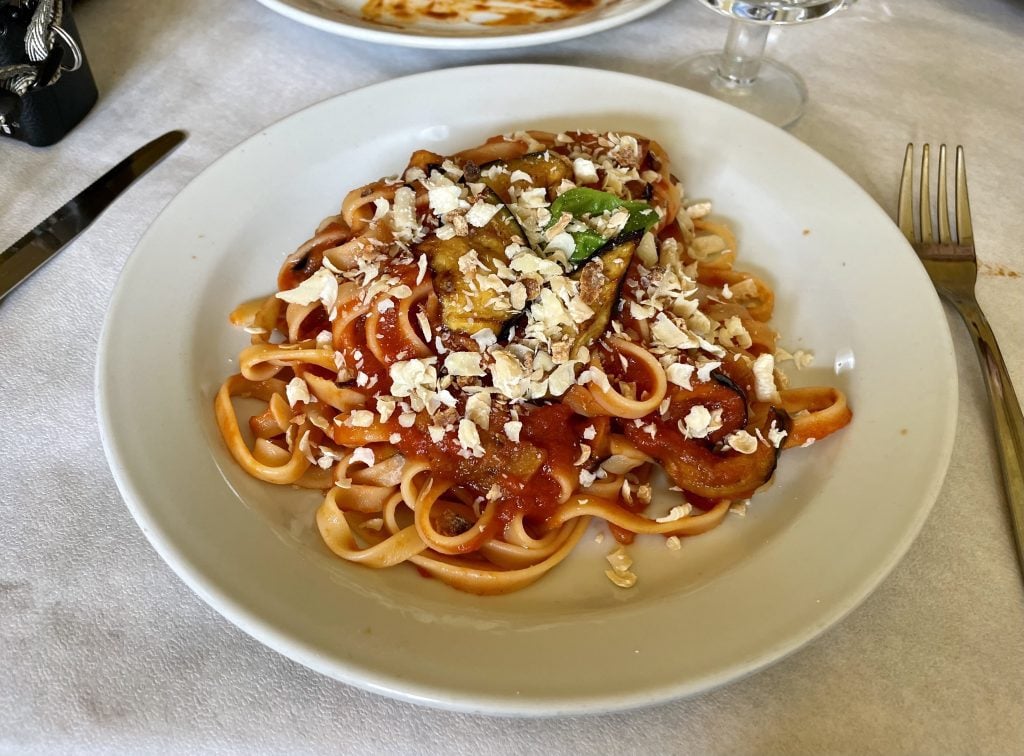
Sicilian Pastas
Pasta alla Norma
If you’re looking for a basic Sicilian pasta dish, one that is on most menus, take a look at pasta alla Norma. Pasta is served with tomato sauce, fried eggplant, basil, and topped with grated ricotta salata cheese.
Note that ricotta salata, or salted ricotta, is very different from the typical smooth ricotta cheese you might pick up at the grocery store. Ricotta salata has been pressed, salted, and aged, and is crumbly and very salty.
You can find pasta alla Norma anywhere in Sicily, but it originated in Catania and remains a source of pride in the city. The dish is named for Catanian composer Vicenzo Bellini, who composed the opera La Norma.
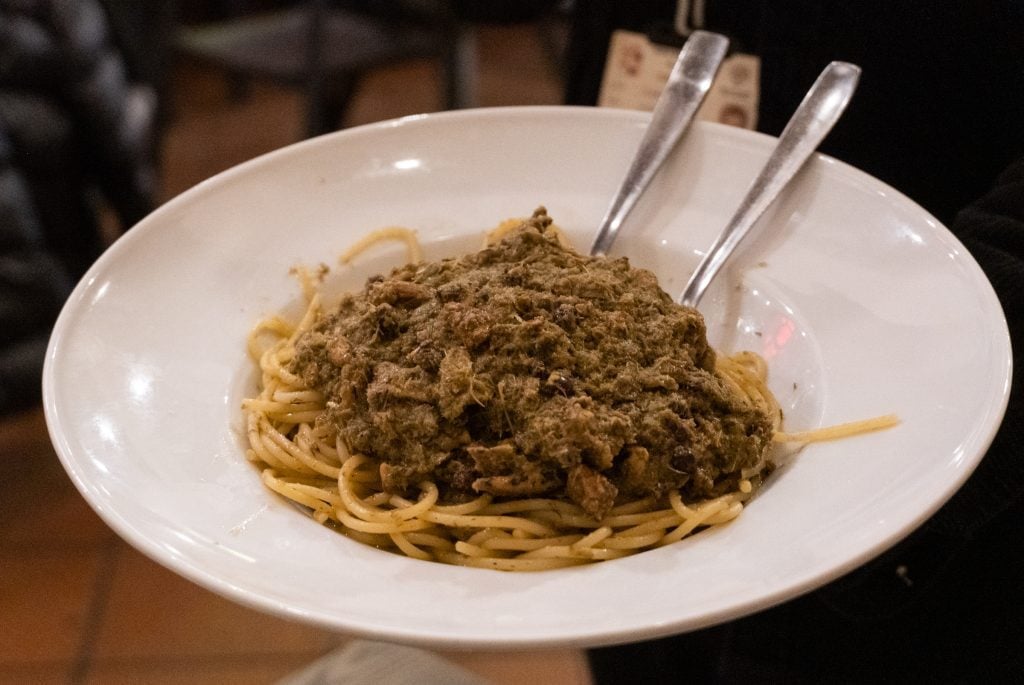
Pasta con le Sarde
Perhaps Sicily’s most famous (or infamous?) pasta is pasta con le sarde, or pasta with sardines. This pasta dish originated in Palermo, and should be eaten in Palermo, though you can sometimes find it in other parts of the island these days.
The sauce is a mix of sardines and anchovies with onions, wild fennel, raisins, pine nuts, and saffron, topped with bread crumbs for texture. The traditional pasta to use is bucatini, though you can find it with various types of pasta.
Raisins and sardines in a pasta — together? I know, it sounds a bit nuts. But trust me — this is one of the most famous Sicilian pasta dishes for good reason, and is a marvelous blend of Italian, Arab, and pan-Mediterranean cuisines.
Wild fennel has an intense flavor and is easily found in Italy, but can be tough to find elsewhere. You can use regular fennel fronds, bulbs, and seeds if you can’t find wild fennel where you live.
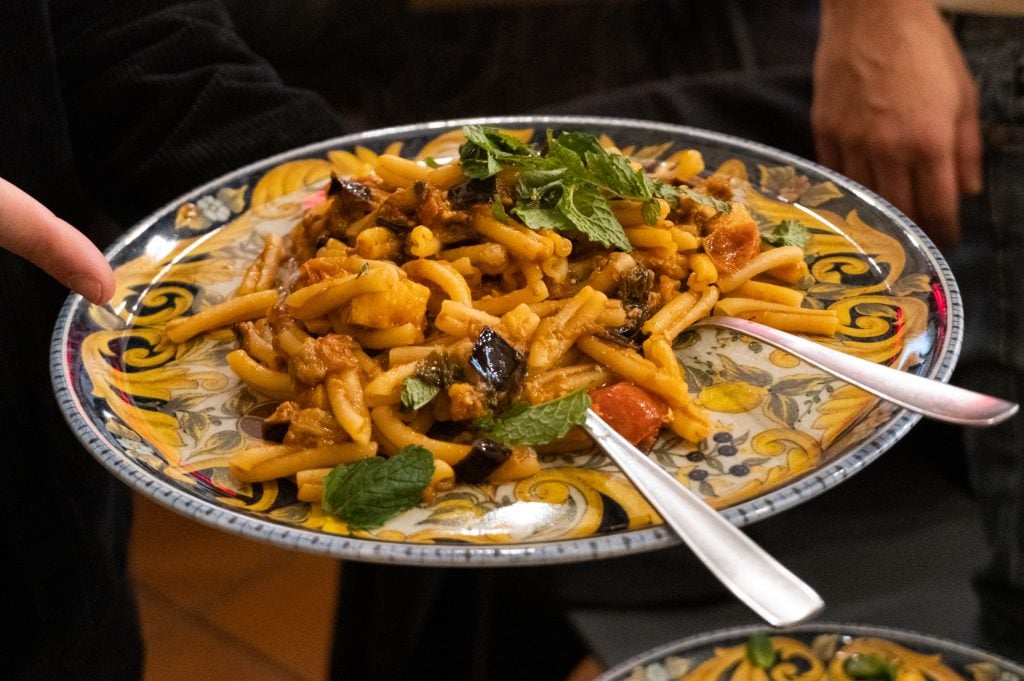
Pasta alla Lido (Pasta Pesce Spada)
Another popular Sicilian pasta is pasta alla Lido, sometimes called Pasta Pesce Spada. This pasta has a source of tomato, eggplant, small pieces of swordfish, and mint leaves.
The pasta is usually casarecce — a flat rectangular pasta shape that curls into itself, a bit like a long maccheroni but not quite a tube.
This is a fantastic Sicilian pasta, using classic Sicilian ingredients that you find almost everywhere — and the mint leaves just add a lovely brightness to the dish.
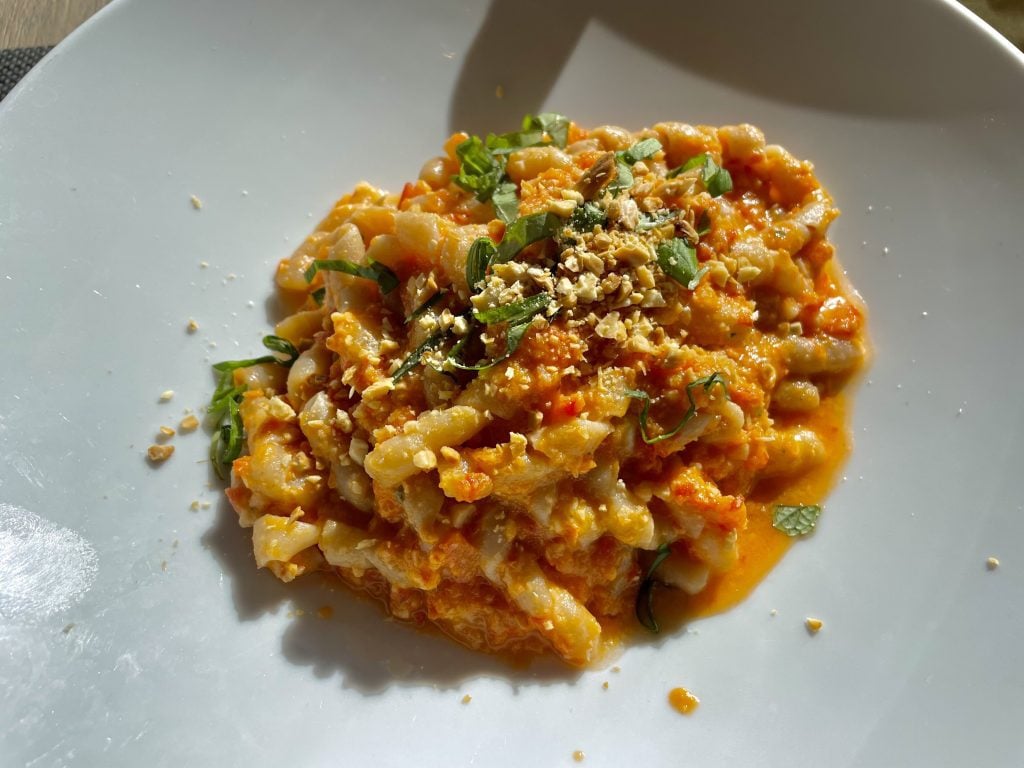
Busiate Alla Trapanese
Busiate is a kind of pasta that looks a bit like an old-school telephone cord — long and spiraled. It originally comes from Trapani province, the westernmost part of Sicily, and is formed by twisting the pasta around a local grass, ampelodesmos.
Pesto alla trapanese is a bit different from the pesto you’re used to up in Genoa — this pesto is made from almonds, grated pecorino cheese, tomatoes, basil, and garlic. Occasionally it’s called pesto alla siciliana.
This is another excellent vegetarian pasta dish in Sicily. The almonds really give it a heft!
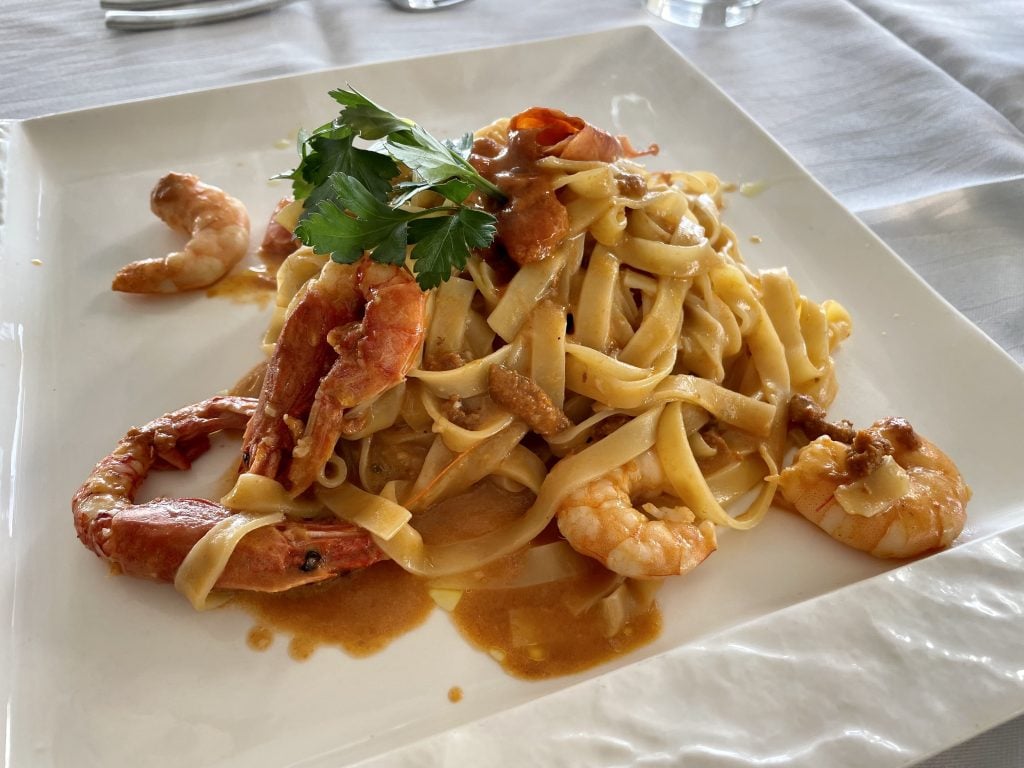
Pasta Coi Ricci
Pasta coi ricci, sometimes called pasta ai ricci di mare, is pasta with sea urchin — an expensive but oh so delicious local specialty in Sicily! If you’re using fresh sea urchins pulled from the sea that morning, it’s a bit time-consuming to remove the edible flesh. But you’ll be rewarded with a deep, complex flavor.
Sea urchin is a winter delicacy in Sicily. The season usually runs from November through April.
This pasta is usually simple — just sea urchin cooked with olive oil, garlic, and salt. But occasionally you’ll find pastas that throw other seafood into the dish, like the shrimp that found their way into our dish above!
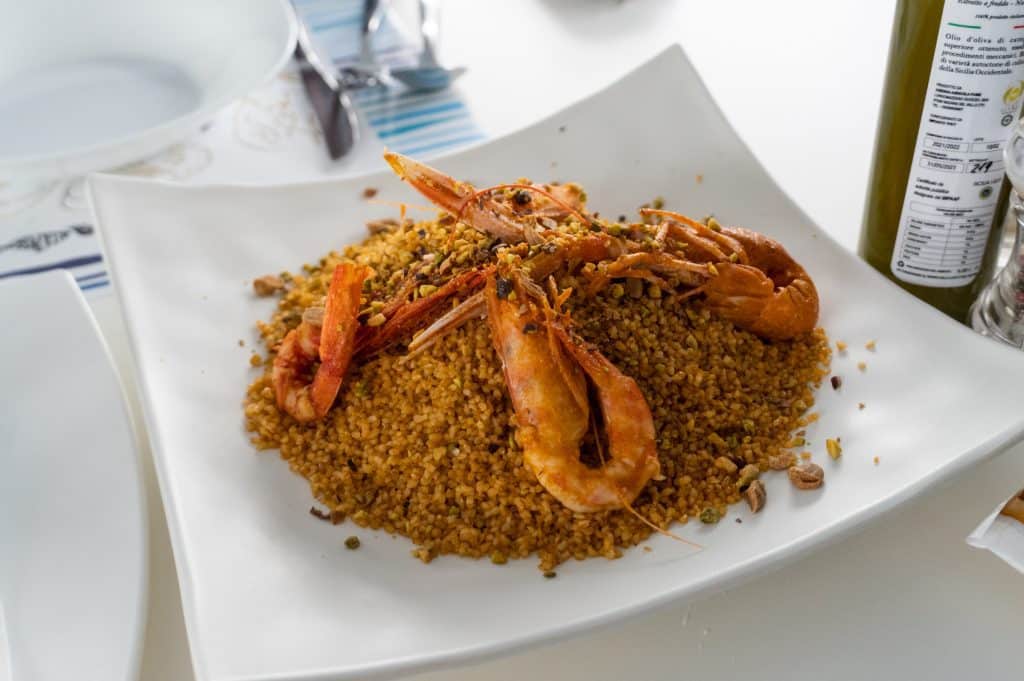
Couscous alla Trapanese
One of the best ways to see the influence of North Africa in Sicilian cuisine is to head to Trapani province. Here, couscous often accompanies dishes instead of pasta!
But that’s where the cuisines diverge. While Moroccan couscous is usually served with meat, couscous alla trapanese is served with fish or seafood of any kind. It’s seen as a primo piatto here, or a first course, on par with pasta. Flavors like saffron can up the intensity.
And if you can’t get enough of Sicilian couscous, Cous Cous Fest takes place in the town of San Vito Lo Capo each September!
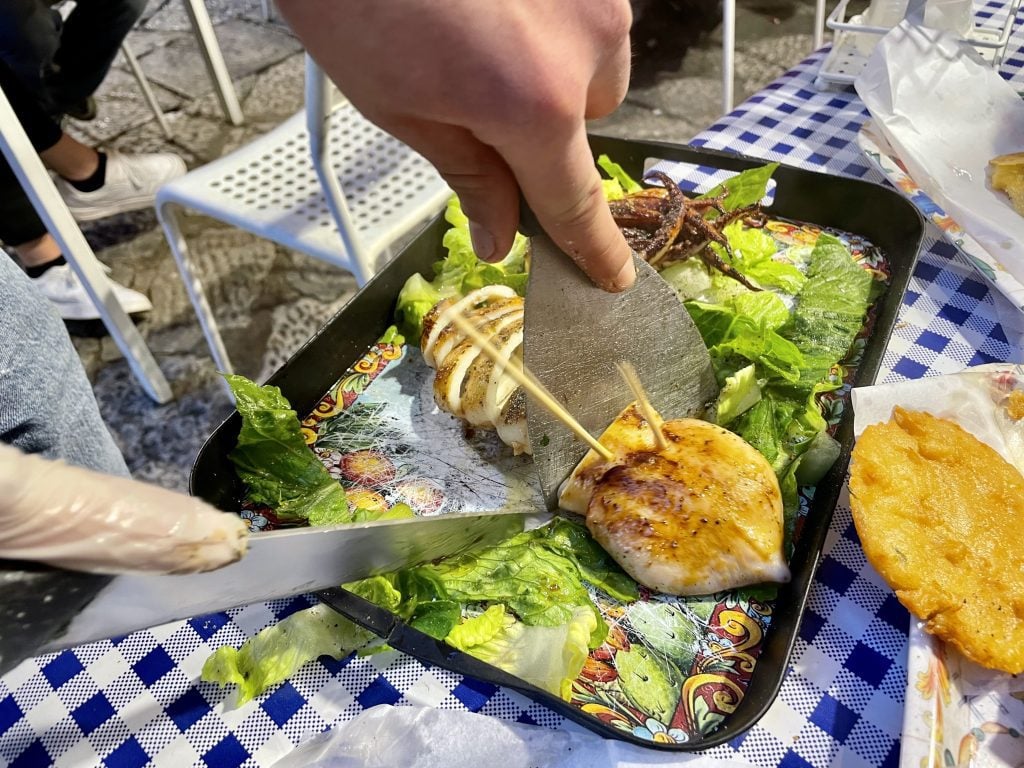
Sicilian Seafood
In Sicily, it’s all about seafood — when you’re on the coast, it’s often hard to find a main dish that isn’t seafood! (If not, it’s usually veal — the chicken of Italy.) And usually that means what’s fresh and local, served simply.
Sicilian menus often feature sardines (sarde), anchovies (alici), tuna (tonno), swordfish (pesce spade), octopus (polpo) and squid (calamari).
Beyond that, there are Sicilian seafood dishes that you should keep an eye out for. Here they are:
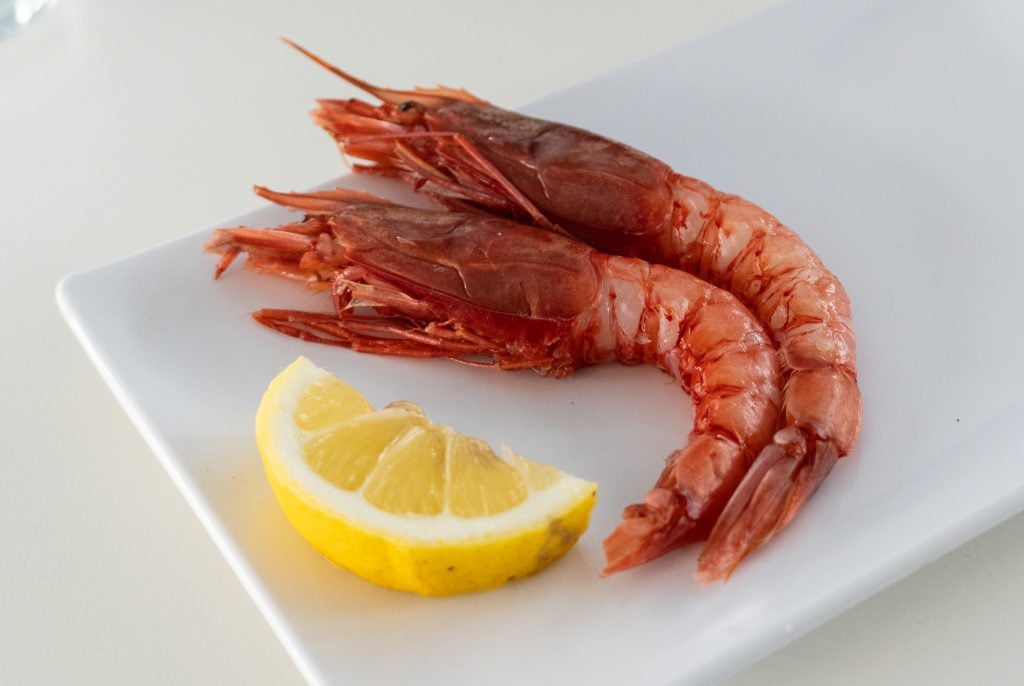
Gambero Rosso di Mazara
Sicilians love shrimp (or prawns, as you Brits call them) — but there is one kind of shrimp that is especially lauded throughout Sicily. The gambero rosso di Mazara, or the red shrimp from the town of Mazara del Vallo in Trapani province. They’re also called ammaru russu in Sicilian.
Mazara del Vallo is one of the largest fishing ports in Sicily, and these shrimp are fished throughout the ocean southwest of the island, the closest part to Tunisia.
The shrimp have a unique sweet flavor and are served raw. You can enjoy them on their own or mixed into another dish — I had a wonderful pasta with pistachio pesto, burrata, and red shrimp at Ngonia Bay hotel in Milazzo.
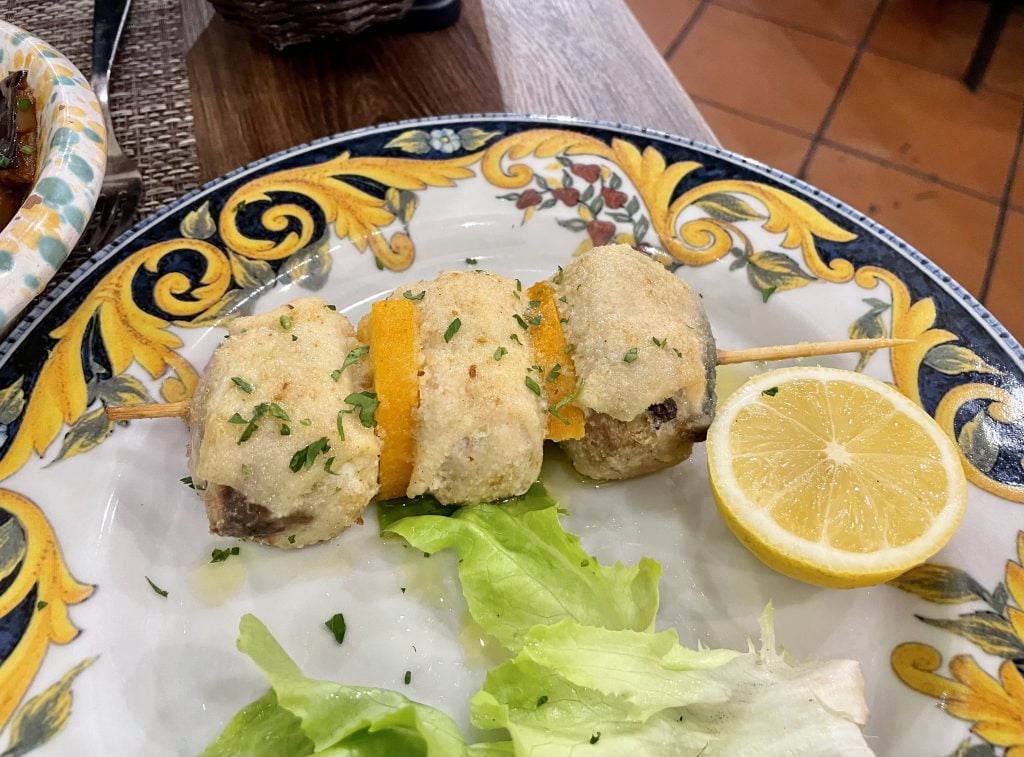
Involtini di Pesce Spade
You might have heard of eggplant involtini — little rolled up eggplant, served as an appetizer — but have you heard of swordfish involtini? Involtini di pesce spade are swordfish rolls, served as a secondo piatto (second course).
Thin filets of swordfish are wrapped around seasoned breadcrumbs, sometimes with raisins and pine nuts, and baked.
This dish is a great example of Sicilians stretching their proteins far — a small amount of swordfish can feed a large family when prepared this way.
Sarde a bettafico is a similar dish made with butterflied sardines wrapped around the breadcrumbs mixture.
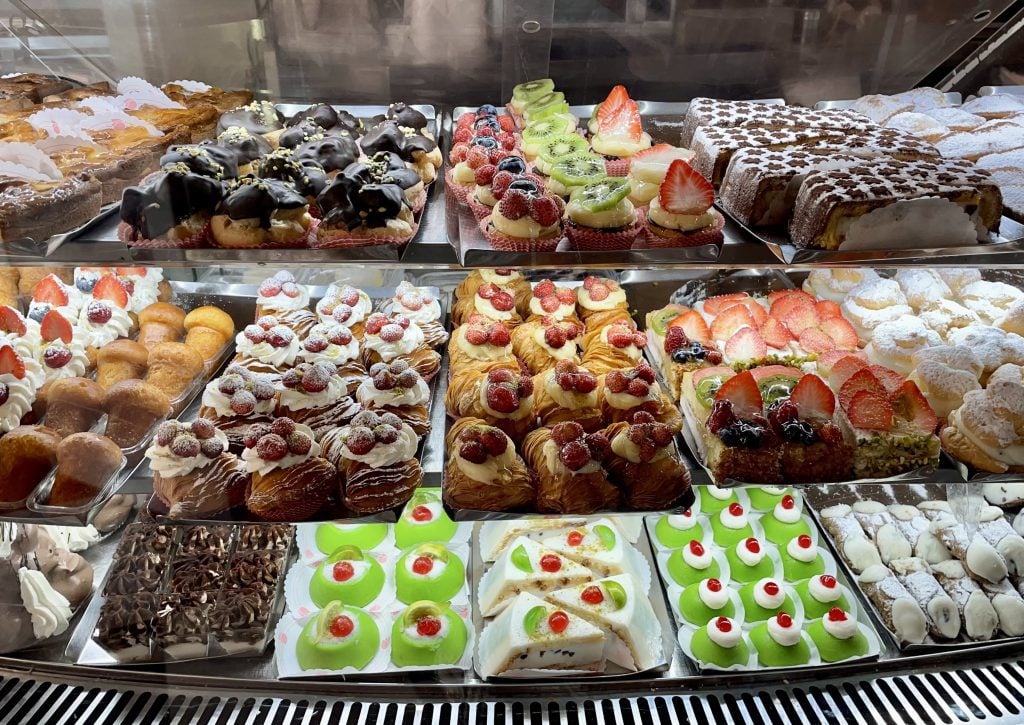
Sicilian Desserts and Sweet Treats
Honestly, I think one of the highlights of visiting Sicily is the desserts. I think Sicily has the best desserts in all of Italy!
You’ve no doubt heard of cannoli, and you may have tried a granita or two, but Sicilian desserts get much more intense than that.
My recommendation? Every afternoon, stop for a coffee and a treat to satisfy your sweet tooth. One of the nice things about Sicilian bakeries is that they often make each dessert in mini sizes as well. Perfect for sampling!
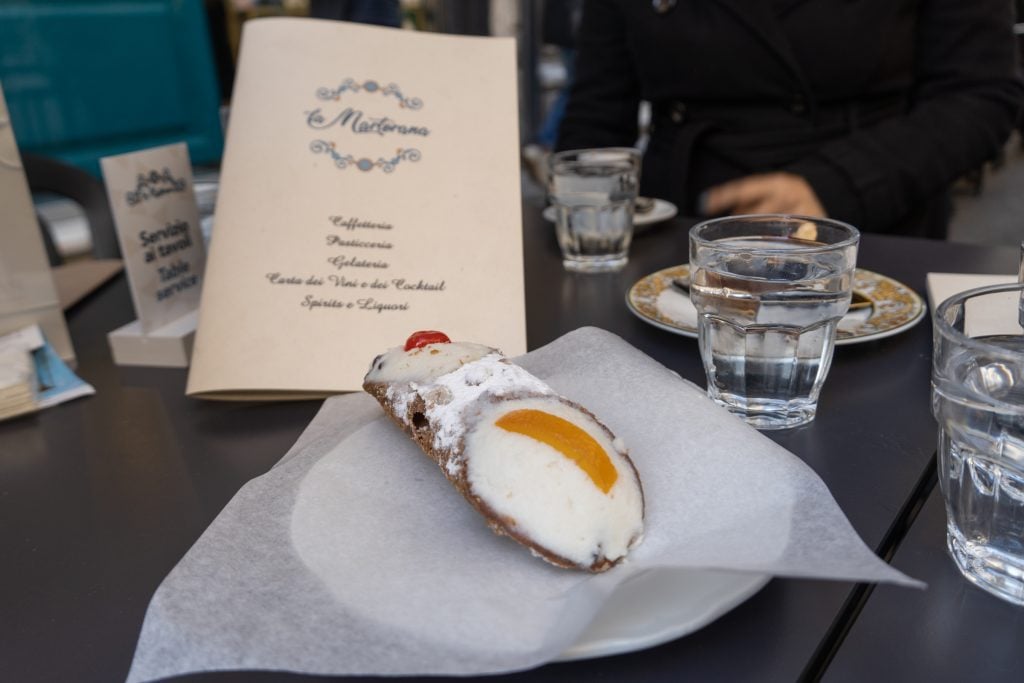
Cannoli
Of all Sicilian desserts, what’s more famous than a cannoli? Or cannolo, actually. In the Italian language, cannolo is singular and cannoli is plural. Mainland Italy calls them cannoli siciliani.
You know this one — it’s a fried pastry shell shaped like a tube, called a scorza, and filled with ricotta. (Ideally, the shells should be empty until you order them and then filled with ricotta, though not every place follows this step.)
In Sicily, cannoli are often topped with candied oranges or cherries, filled with chocolate chips, or dusted with chopped pistachios. Some shells are made with marsala wine.
And they come in different sizes — have a mini cannolo accompanying your caffe macchiato after lunch, or grab a full-sized one that could double as a murder weapon.
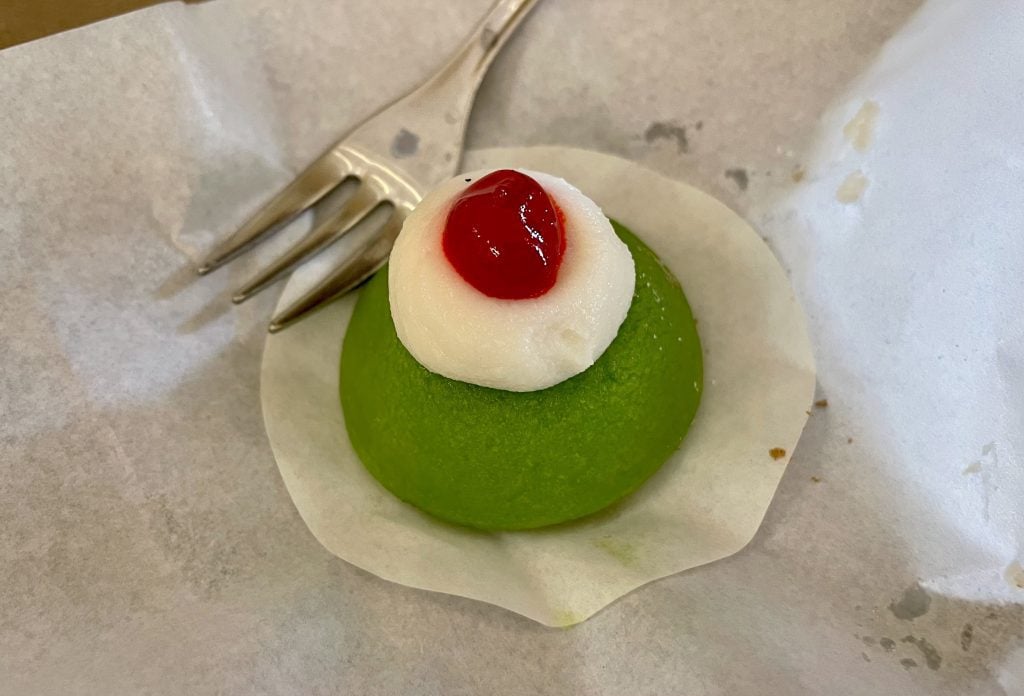
Cassata
And now for the second most famous Italian dessert: cassata! Cassata is made with layers of sponge cake moistened with liqueur, ricotta, and candied fruit. Beyond that, there’s quite a bit of variation in cassata, which originated in Palermo but you can find throughout the island.
Cassata siciliana is the famous bright green cassata, usually with lots of candied fruit or geometric designs or a cherry on top. It’s wrapped in marzipan and has vivid almond and pistachio flavors.
Cassata al forno is more similar to a ricotta pie, with a shortcrust pastry wrapped around ricotta, sponge cake, and sometimes chocolate. This version is more common in Catania and sometimes called cassata Catanese.
And of course, there are the minne di vergine, or virgins’ breasts (!) — a version of cassata served for the festival of Sant Agata in Catania (though I did find some in Palermo, too). This one is white and topped with a cherry, of course.
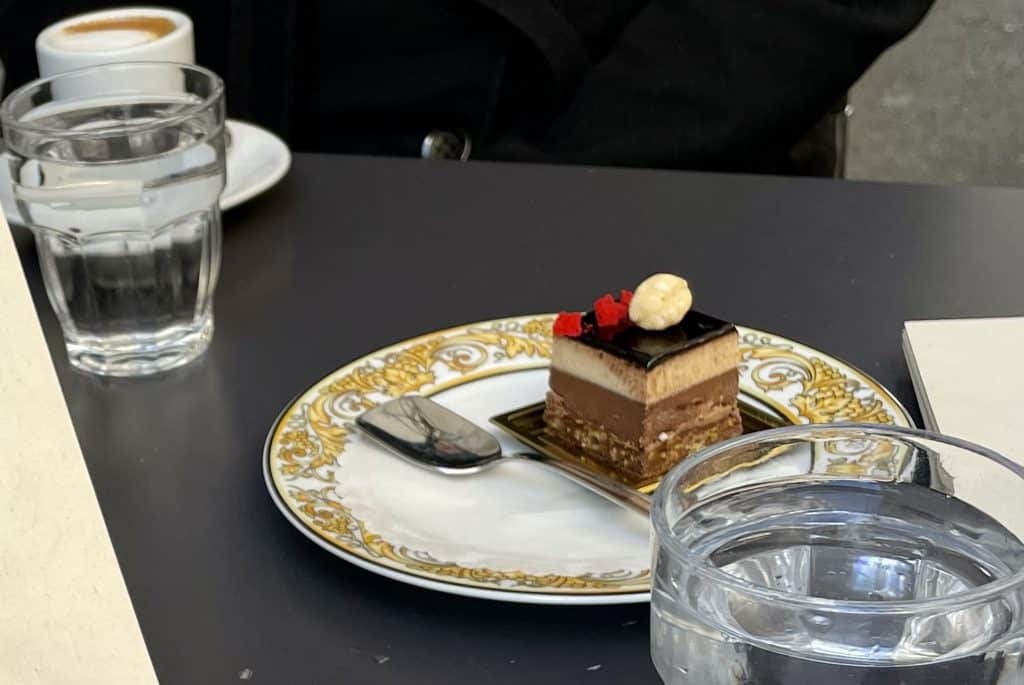
Torta Setteveli
If you’re enjoying the desserts in Palermo but craving something a bit more chocolatey, you’ll want to check out the torta setteveli — a rich cake made of layers of chocolate and hazelnuts. The name means seven-veil cake in Italian, and it takes the form of seven layers.
The cake consists of two layers of chocolate cake, two layers of hazelnut cream, and one layer each of chocolate mousse, hazelnut crunch, and a glossy mirror glaze on top. (If you’re a baker and looking for a challenge, this requires a lot of different steps! No wonder it was a technical challenge on The Great British Bake-Off.)
This is a popular birthday cake in Palermo — but you’re welcome to have it just to celebrate being in Sicily!
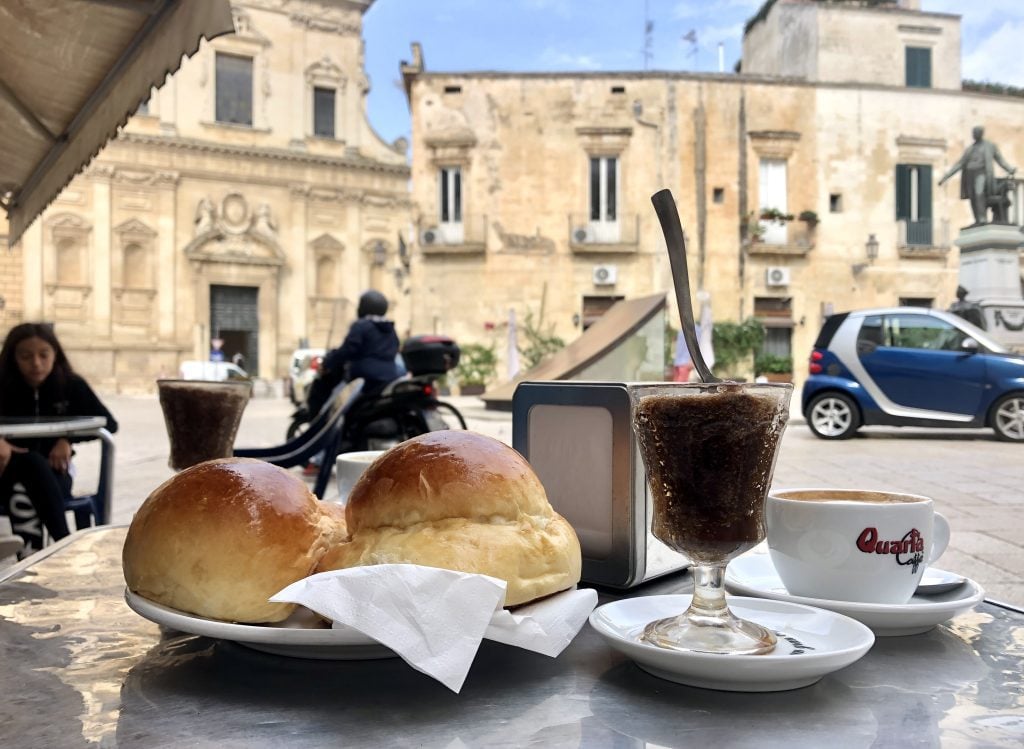
Granita con Brioche
When you visit Italy, you’re used to seeing gelato spots on every block. When you get to Sicily, you might be wondering why there are so few of them! Sure, gelato exists, but granita is the cold sweet treat of choice in Sicily.
Granita is similar to slush — it’s a smooth semi-frozen dessert. And in Sicily, granita con brioche is granita served with a brioche — a delicious breakfast on a hot day! Yes, this is breakfast!
In Sicily, some of the most popular granita flavors are mandorla (almond), limone (lemon), pistacchio (pistachio), fragola (strawberry), caffe (coffee, black with sugar), mandarino (mandarin) and gelso (mulberry). The texture tends to be smoother in Eastern Sicily and chunkier in Western Sicily.
You can also get it topped with crema, either served as whipped cream or liquid cream, if you’d like. I’m still dreaming of the caffe granita with cream I had in Salina in the Aeolian Islands.
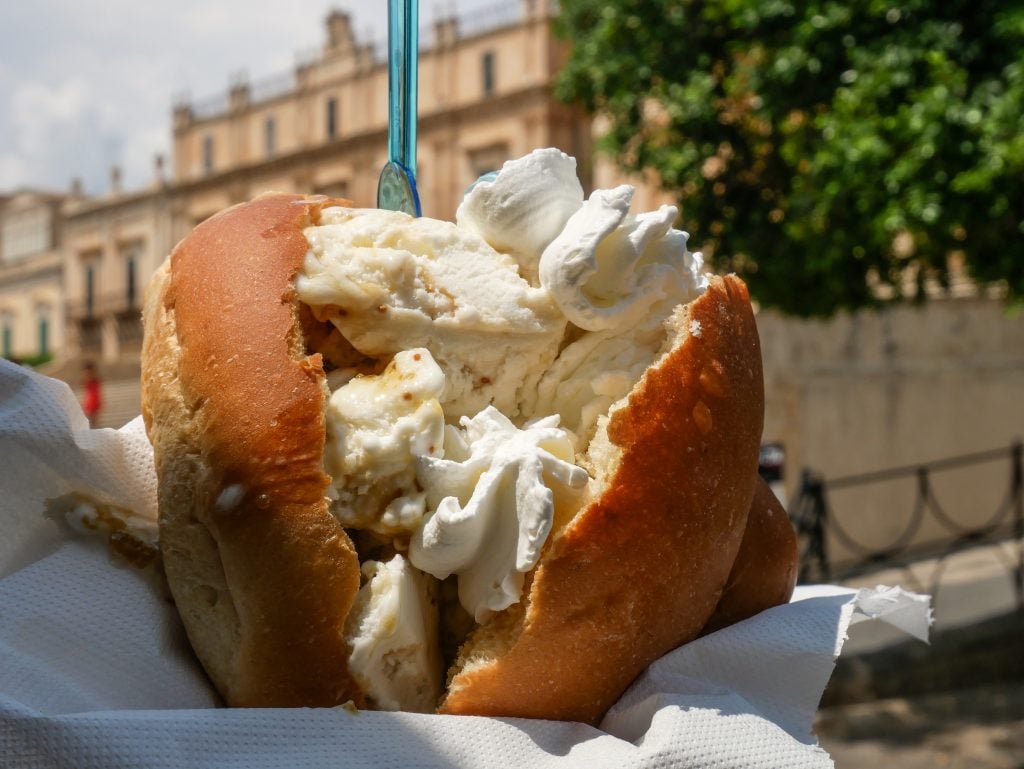
Brioche con Gelato
So how is gelato served in Sicily when they do have it? Often in a brioche con gelato! This is the ultimate ice cream sandwich — scoops or a slab of gelato are put between two halves of a sweet brioche.
And yes — like granita con brioche, brioche con gelato is eaten for breakfast in Sicily. The gelato melts into the buttery bun and makes a fabulously indulgent start to your day.
And sometimes the ice cream seller will even offer you cream to put on top of the gelato. Because this dish wasn’t decadent enough!
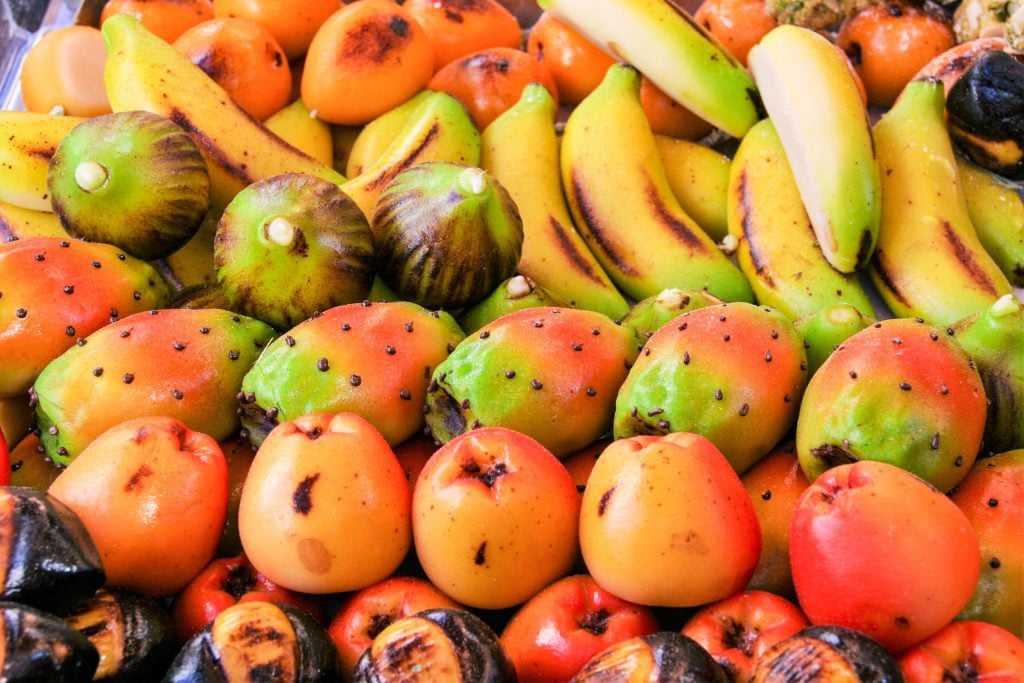
Frutta Martorana
In Sicilian bakeries and cafes, you’ll often see baskets of brightly colored sweets painted to look like fruits and vegetables. These are frutta martorana — traditional marzipan sweets that originated in Palermo.
They’re softer than you think, and so wonderfully almondy.
Frutta martorana is a traditional dessert served on All Soul’s Day. While it originated in Palermo, you can find it year-round throughout Sicily.
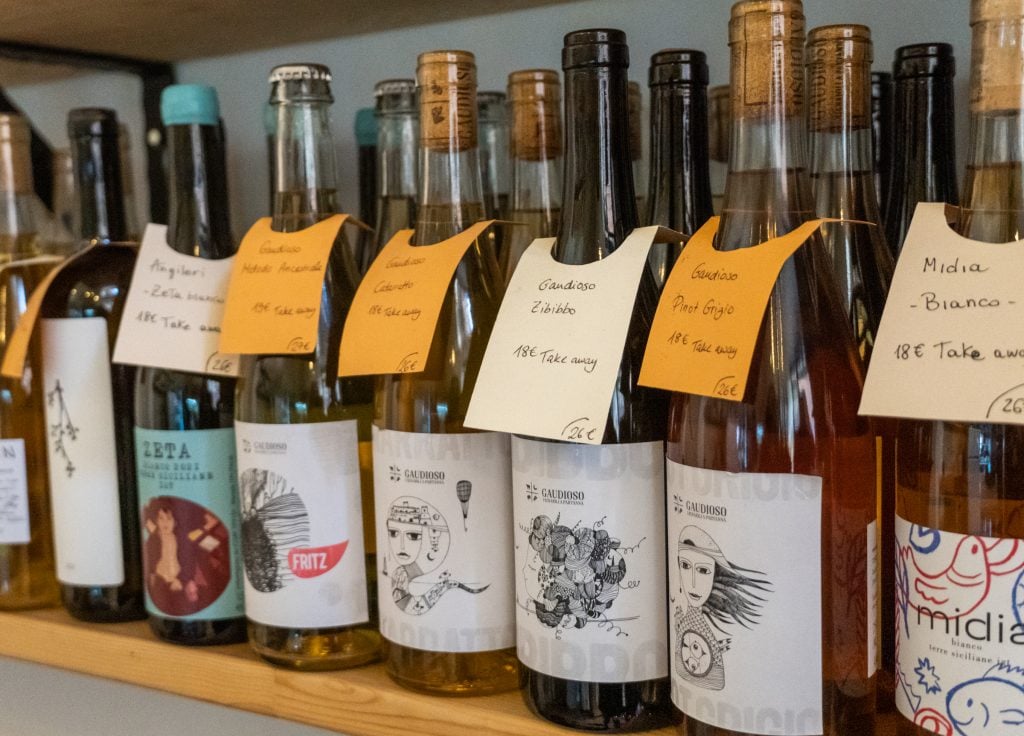
What to Drink in Sicily
Like most Italians, Sicilians tend to drink wine, water, and coffee with great enthusiasm.
Sicilian Wines
Italians are justifiably proud of their indigenous grape varietals. In Sicily, the local wine that you’ve probably heard of is Nero d’Avola — a deep, full-bodied red wine from southeast Sicily.
As for whites, Grillo and Carracante are two solid Sicilian white wine choices that you’ll see on menus throughout the island. Malvasia is a popular white wine from the Aeolian Islands worth trying.
Sicily also makes excellent sweet wines. Marsala is a sweet wine from southwest Sicily that you’ll see around.
It can be a bit overwhelming choosing an Italian wine if you’re not familiar with their varietals. (I often say that one of the biggest mistakes travelers make in Italy is constantly ordering Chianti because it’s the one Italian varietal they’ve heard of.)
To get around this, you can always ask for the vino della casa (house wine) or ask your server for a recommendation. Or pick a bottle at random if you’re feeling adventurous! Wine can be pretty cheap in Sicily.
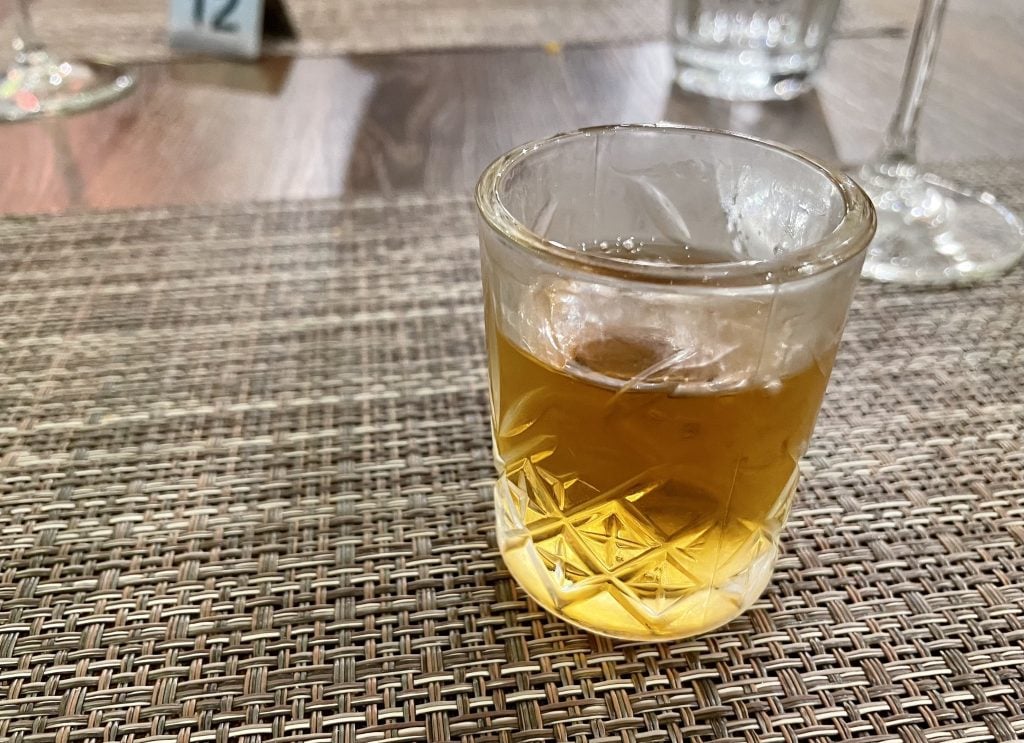
Sicilian Digestivi
A digestivo is a liqueur consumed at the end of your meal to aid digestion. Does it work? Who knows, but it’s the classic way to end your meal in Sicily!
The most popular Sicilian digestivo is Amaro. Amaro is a bittersweet liqueur made from herbs, roots, spices, citrus peels, neutral alcohol or wine, and sugar syrup. It comes served neat — sip away!
If you want to go more fruity than bitter, Sicilians also make their own limoncello, arancello, and other fruity digestives.
More on Sicily:
- The Joys and Challenges of Traveling in Sicily
- Where to Go in Eastern Sicily
- 23 Fun Things to Do in Palermo, Sicily
- Complete Guide to the Aeolian Islands, Sicily
- Aci Trezza: A Laid-Back Coastal Town in Sicily
- Visiting Sicily in the Winter: Worth it or not?
Cool Places in Southern Italy:
- Tropea, Italy: A Spectacularly Situated Beach Town
- The Stunning Trulli of Alberobello, Italy
Cool Places in Northern Italy:
- Three Weeks in Northern Italy: An Itinerary
- Parma, Italy: A Colorful, Artsy, Delicious Town
- Where to Stay in Rome: Best Neighborhoods and Accommodation
- Three Days in the Dolomites: A South Tyrol Getaway
- Best Day Trips from Florence, Italy
- The Immaculate, Bursting Mosaics of Ravenna, Italy
- 25 Best Food Experiences in Emilia-Romagna, Italy
Planning a Trip to Italy:
- What NOT to Do in Italy
- Solo Female Travel in Italy: Is it Safe?
- Ultimate Guide to Driving in Italy
- How to Stay at an Agriturismo in Italy

What’s your favorite Sicilian food? Share away!
The post Sicilian Food: 30 Iconic Dishes + What to Eat in Sicily appeared first on Adventurous Kate.
Sicilian Food: 30 Iconic Dishes + What to Eat in Sicily
| Divisions of Shy Paris Entertainment | ||||
|---|---|---|---|---|
| Shyparis Entertainment | Shy Paris Bookings | Linkz Radio | Klublinks | Shy Paris |
❤Shy Paris Entertainment ||||| International Spectacular Events, Stellar Event Planning and Management, & Celebrity Booking Agency. Please contact us as we can provide you with both international and/or local renowned full service event planning and management, & celebrity bookings at shyparisentertainment@gmail.com or
CONTACT: Email: shyparisentertainment@gmail.com
Facebook: ShyParis Youtube: @Shyparis Twitter: @Shyparisent Instagram: shyparisentertainment Whatsapp: 1-437-259-3399
✶✶✶✶✶✶✶✶✶✶✶✶✶✶✶✶✶✶✶✶✶✶✶✶✶✶✶✶✶✶✶✶✶✶✶✶✶✶✶✶✶✶✶✶✶✶✶✶✶✶
SHY PARIS ENTERTAINMENT COMPANIES
✅ ShyParisentertainment.co – https://shyparisentertainment.co
✅ Shyparisbookings.com – https://shyparisbookings.com
✅ Linkzradio.com – https://linkzradio.com
✅ Klublinks.com – https://klublinks.com
✅ Shypariswebdesign.com – https://shypariswebdesign.com
✅ ❤️ Shyparis – htttps://shyparis.com❤️
